Diffraction
- When
a wave is disturbed by the edge of a barrier circular wavefronts are produced.
- If the wave passes
through a gap in a barrier circular wavelets are produced at each edge
and the rest of the enegy just goes straight through
- The frequency, wavelength
and speed of the waves is not altered.... but the amplitude of the part
of the wave that spreads out is lower - as the energy is distributed over
a bigger area!
Diffraction can be demonstrated by using a ripple tank in the laboratory
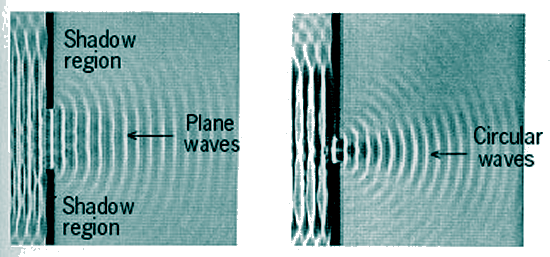
Large
gap in the barrier
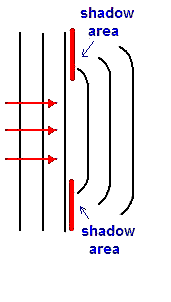 If
the gap is large, compared to the wavelength of the waves passing through ,the circular disturbances are tiny compared to the
undistrubed wavefronts.
If
the gap is large, compared to the wavelength of the waves passing through ,the circular disturbances are tiny compared to the
undistrubed wavefronts.
Therefore most of the energy just continues
through without change.
But, at the edge, the straight wavefront breaks
into circular fronts and so just the energy at the edges spreads out
(diffracts).
The percentage of the total energy that gets through the
gap that breaks up and spreads out (diffracts) is tiny compared to the
total amount that gets through - therefore the majority of the energy
just travels straight and you are hardly aware of the bit that 'spreads'
This means that:
 large
straight wavefronts get through the big gap - travelling undisturbed
large
straight wavefronts get through the big gap - travelling undisturbed
 a tiny
disturbance at the edge of the straight wavefront leads to
slight curving of the wavefronts at the edge and a slight
spread
a tiny
disturbance at the edge of the straight wavefront leads to
slight curving of the wavefronts at the edge and a slight
spread
 this
leads to a 'shadow area' where very little of the energy travels
to.
this
leads to a 'shadow area' where very little of the energy travels
to.
Small
gap in the barrier
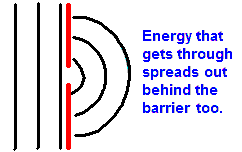 If
the gap is small (about the same size as the wavelength of the wave passing through) the circular disturbances that get through are massive
compared to the undistrubed wavefronts. Therefore hardly any of the
energy just continues through without change. Rather, at the edges the
straight wavefront breaks into circular fronts spreading the energy
out behind the barrier (considerable diffraction occurs).
If
the gap is small (about the same size as the wavelength of the wave passing through) the circular disturbances that get through are massive
compared to the undistrubed wavefronts. Therefore hardly any of the
energy just continues through without change. Rather, at the edges the
straight wavefront breaks into circular fronts spreading the energy
out behind the barrier (considerable diffraction occurs).
As this is the way
that virtually all of the energy gets through:
 only
circular wavefronts are observed passing through the tiny
gap in the barrier (instead of straight ones)
only
circular wavefronts are observed passing through the tiny
gap in the barrier (instead of straight ones)
 the energy
spreads out behind the barrier
the energy
spreads out behind the barrier
 there
is no shadow area behind the barrier.
there
is no shadow area behind the barrier.
Why
can you hear around corners but not see round them?
A doorway is a tiny
gap for a soundwave of wavelength 1.3m (a note of middle C) but is enormous
for a light wave of wavelength 600 nm!
Therefore we can hear round corners,
because the sound waves diffract around the edges of the doorway- making
the bulk of the energy spread out in all directions through the 'gap'
of the door.... but we can't see round doorways, beacuse a miniscule quantity
of the light energy will diffract and the bulk of it will travel straight
through.
Why
do radiowave signals 'bend' around mountains into the valleys below whereas
microwave (Cell phone) signals get blocked by them?
Radiowave signals
have a much longer wavelength than the microwave (or very shortwave radiowaves
- as cell phone companies prefer to call them!). Therefore the diffraction
they suffer is much greater and the signal 'spreads' out into the valley
area.... it is weaker than if it had been able to go through without the
mountain there.... but it does get through!
Why
does light split into its colours when it is diffracted?
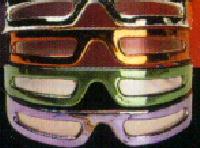 The wave's appreciation
of the 'size of the gap' depends on its wavelength. Red light has a bigger
wavelength than blue light. therefore a gap looks smaller to a red ray
of light than it does to a blue one! Therefore the red end of the spectrum
of light diffracts more than blue end when white light is passed through
a tiny gap (such as that found in a diffraction
grating). 'Laser specs' have diffraction gratings as lenses and let
you see lots of pretty coloured effects when you look at anything... they
are letting you see diffraction patterns.
The wave's appreciation
of the 'size of the gap' depends on its wavelength. Red light has a bigger
wavelength than blue light. therefore a gap looks smaller to a red ray
of light than it does to a blue one! Therefore the red end of the spectrum
of light diffracts more than blue end when white light is passed through
a tiny gap (such as that found in a diffraction
grating). 'Laser specs' have diffraction gratings as lenses and let
you see lots of pretty coloured effects when you look at anything... they
are letting you see diffraction patterns.
Diffraction
Spikes
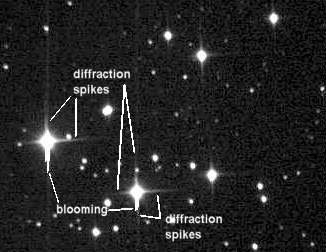 In the image on the right, the brightest stars can be seen to exhibit
'diffraction spikes'. These most commonly appear as four relatively
faint projections radiating outward from the star arranged 90 degrees
from each other, but can also appear as two projections on opposite
sides of the star. Diffraction spikes are caused by light diffracting
around the support vanes of the telescope's secondary mirror.
In the image on the right, the brightest stars can be seen to exhibit
'diffraction spikes'. These most commonly appear as four relatively
faint projections radiating outward from the star arranged 90 degrees
from each other, but can also appear as two projections on opposite
sides of the star. Diffraction spikes are caused by light diffracting
around the support vanes of the telescope's secondary mirror.
(taken
from http://www.chapman.edu/oca/gallery2/artifact.htm)
- This is a great interactive page from the University of Salford!




 If
the gap is large, compared to the wavelength of the waves passing through ,the circular disturbances are tiny compared to the
undistrubed wavefronts.
If
the gap is large, compared to the wavelength of the waves passing through ,the circular disturbances are tiny compared to the
undistrubed wavefronts.  If
the gap is small (about the same size as the wavelength of the wave passing through) the circular disturbances that get through are massive
compared to the undistrubed wavefronts. Therefore hardly any of the
energy just continues through without change. Rather, at the edges the
straight wavefront breaks into circular fronts spreading the energy
out behind the barrier (considerable diffraction occurs).
If
the gap is small (about the same size as the wavelength of the wave passing through) the circular disturbances that get through are massive
compared to the undistrubed wavefronts. Therefore hardly any of the
energy just continues through without change. Rather, at the edges the
straight wavefront breaks into circular fronts spreading the energy
out behind the barrier (considerable diffraction occurs).  The wave's appreciation
of the 'size of the gap' depends on its wavelength. Red light has a bigger
wavelength than blue light. therefore a gap looks smaller to a red ray
of light than it does to a blue one! Therefore the red end of the spectrum
of light diffracts more than blue end when white light is passed through
a tiny gap (such as that found in a
The wave's appreciation
of the 'size of the gap' depends on its wavelength. Red light has a bigger
wavelength than blue light. therefore a gap looks smaller to a red ray
of light than it does to a blue one! Therefore the red end of the spectrum
of light diffracts more than blue end when white light is passed through
a tiny gap (such as that found in a  In the image on the right, the brightest stars can be seen to exhibit
'diffraction spikes'. These most commonly appear as four relatively
faint projections radiating outward from the star arranged 90 degrees
from each other, but can also appear as two projections on opposite
sides of the star. Diffraction spikes are caused by light diffracting
around the support vanes of the telescope's secondary mirror.
In the image on the right, the brightest stars can be seen to exhibit
'diffraction spikes'. These most commonly appear as four relatively
faint projections radiating outward from the star arranged 90 degrees
from each other, but can also appear as two projections on opposite
sides of the star. Diffraction spikes are caused by light diffracting
around the support vanes of the telescope's secondary mirror. 


